#and there are no suits in Ancient Rome
Explore tagged Tumblr posts
Text
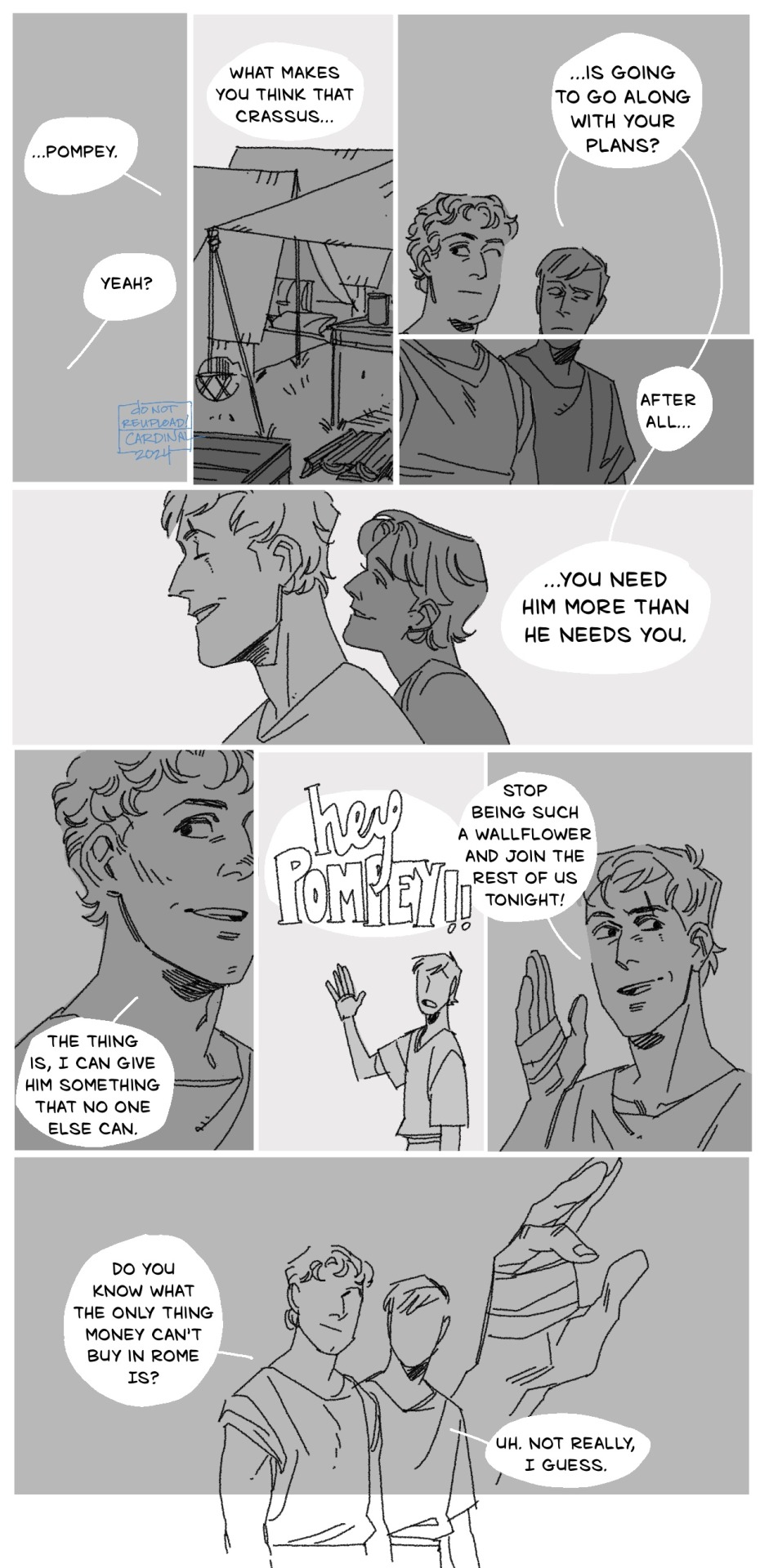
this is a scrapped scene from Trikaranos & originally it joined a standalone series of comics from Pompey’s point of view, but it got scrapped from THAT set too because I decided they both needed to be weirder and worse and this is kind of vanilla ngl. however I’m still kind of fond of it in some kind of way, and it’s been a second since I’ve posted a comic! also I wanted to draw it. so I did.
for context: Crassus cut his hand open helping Pompey out with something in a previous scene! for more context: the answer to Pompey’s question is a reliable (business/political) partner. that’s about it!
⭐ places I’m at! bsky / pixiv / pillowfort /cohost / cara.app / tip jar!
#the hand wound was replaced with a thigh wound and conversation changes currently cuts Pompey’s question out entirely#and replaces ends with the ‘I can give him something that no one else can’ because the answer to the unspoken question of what#comes into play later with a really thorny scene#drawing tag#tris homines#Komiks tag#OOF. that was like stretching muscles or something. every time I do an ides drawing my brain wants nothing to do with#dead Romans at all and it takes a minute to break their that wall. I think last year was the worst one lmao it was 2 months#before I wanted to do anything and liked what I did. this was more like. I’m sleepy. I want to draw uptight men in suits get totally undone#and there are no suits in Ancient Rome#BUT WE DID IT. we broke through the wall. I’m going back to drawing men in suits.#anyway crassus’ hair is a little longer here and he’s going to cut it down but he kind of looks like his dad and I’m going to just#aughghghghh
144 notes
·
View notes
Text



A goddess.
#rome hbo#octavia minor#kerry condon#she's so beautiful#pink suits her very well#ancient rome#period drama
60 notes
·
View notes
Text
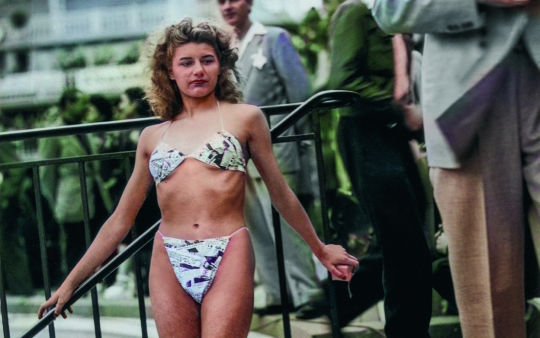
The bikini is the most important thing since the atom bomb.
Diana Vreeland
The origins of contemporary bikini day may be traced back to a French engineer, a Parisian exotic dancer, a nuclear testing site in the United States, and a postwar fabric shortage.
In 1946, Western Europeans joyously greeted the first war-free summer in years, and French designers came up with fashions to match the liberated mood of the people. Two French designers, Jacques Heim and Louis Réard, developed competing prototypes of the bikini. Heim called his the “atom” and advertised it as “the world’s smallest bathing suit.”
French fashion designer Louis Reard was determined to create an even more scandalous swimsuit. Réard's swimsuit, which was basically a bra top and two inverted triangles of cloth connected by string, was in fact significantly smaller. Made out of a scant 30 inches of fabric, Réard promoted his creation as “smaller than the world’s smallest bathing suit.”
Réard claimed that the bikini was named for Bikini Atoll, the site of nuclear tests by the United States in the Pacific Ocean.
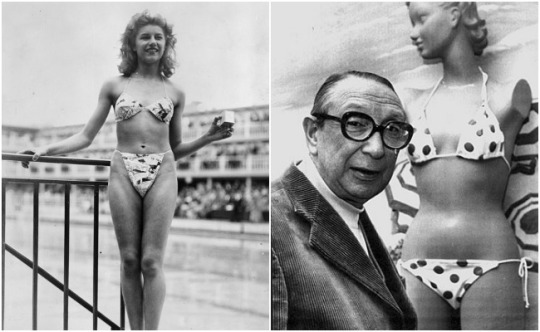
Louis Réard's bikini was so little that he couldn't find anyone brave enough to wear it. After being rejected by a number of fashion models, he came across Micheline Bernardini. She was a 19-year-old nudist at the Casino de Paris who consented to be the first to try on his daring bikini. Michelle Bernardini debuted this revealing costume at the Piscine Molitor in Paris during a poolside fashion show, and it revolutionised swimwear on 5 July 1946. The bikini was a hit, especially among men, and Bernardini received some 50,000 fan letters.
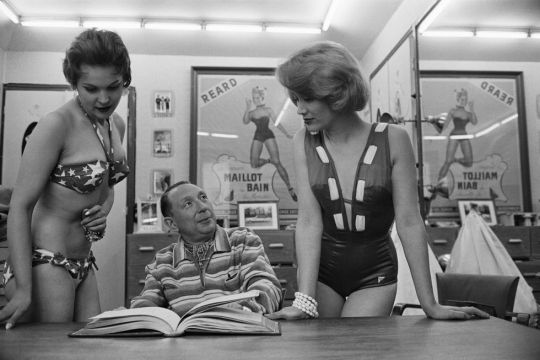
Before long, bold young women in bikinis were causing a sensation along the Mediterranean coast. Spain and Italy passed measures prohibiting bikinis on public beaches but later capitulated to the changing times when the swimsuit grew into a mainstay of European beaches in the 1950s. Réard's business soared, and in advertisements he kept the bikini mystique alive by declaring that a two-piece suit wasn’t a genuine bikini “unless it could be pulled through a wedding ring.”
But it really took when what we would call cultural influencers took to it. It was in 1953, thanks to Brigitte Bardot, that the bikini became a "must-have" and the history of the bikini became historic, when she was photographed wearing one on the Carlton beach at the Cannes Film Festival. She also wore one in 1956, in the film "Et Dieu… créa la femme".
The United States also caught on to the trend, as it was only two years later that Ursula Andress posed in a white bikini on the poster for the James Bond film, Dr. No. The poster created a considerable marketing coup, and women adopted the bikini. According to a study by Time, 65% of younger women adopted the bikini in 1967.
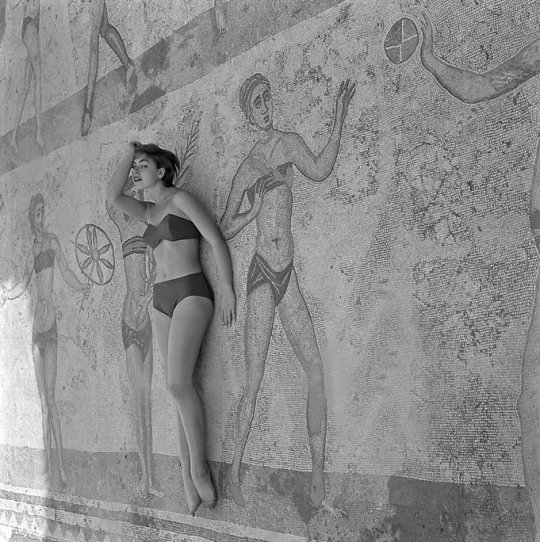
There is no question the bikini is hardly modern. Many think they date back to ancient Roman times because of the murals uncovered in excavated ruins in Sicily. This isn’t really true.
Despite the celebrated images from the mosaics in Piazza Armerina, of the ancient Roman girl wearing what looks like a bikini, the answer is, “not really”. The ancient Roman girls weren’t even first to wear what to our eyes looks like a bikini. However, the fact that we seem to find “bikinis” in ancient depictions should make us rethink our hubristic bias that we in modern times have invented everything and that people in ancient times didn’t know how to live.
Archaeologists have found evidence of bikini-like garments that date to as far back as 5600 BC. That’s roughly 5000 years before the Romans did so. In the Chalcolithic era of around 5600 BC, the mother-goddess of Çatalhöyük, a large ancient settlement in southern Anatolia, was depicted astride two leopards while wearing a bikini-like costume.
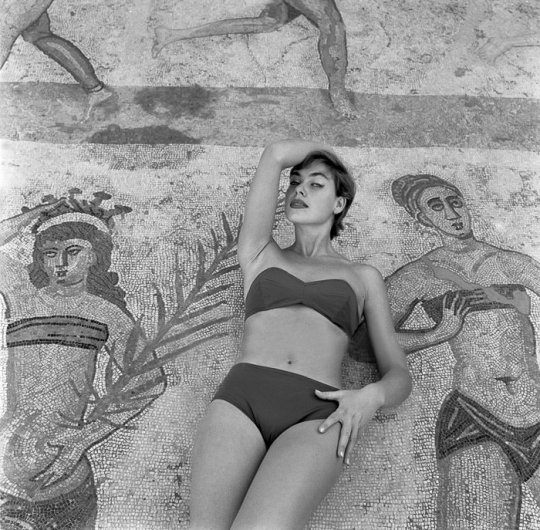
Two-piece garments worn by women for athletic purposes are depicted on Greek urns and paintings dating back to 1400 BC. In fact, even just the notion that women participated in sports in the ancient world should make us sit up and take notice.
Today we tend to imagine women in the ancient world as being practically sequestered in their homes, spinning, weaving and having babies. But this is a gross oversimplification of their role.
Active women of ancient Greece wore a breast band called a mastodeton or an apodesmos, which continued to be used as an undergarment in the Middle Ages. While men in ancient Greece abandoned the perizoma, partly high-cut briefs and partly loincloth, women performers and acrobats continued to wear it.
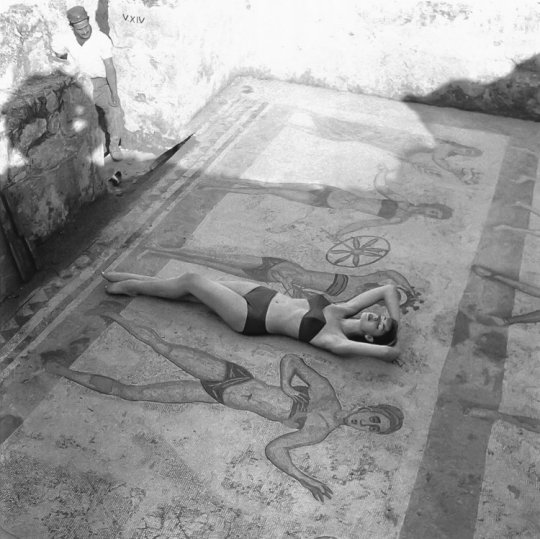
In the famous mosaics to be found at Villa Romana del Casale in Piazza Armerina, the girls who seem to be wearing the “bikini” are Roman and the so-called bikini had already been around for at least 5,000 years by then. In the artwork “Coronation of the Winner” done in floor mosaic in the Chamber of the Ten Maidens (Sala delle Dieci Ragazze) in Sicily the bikini girls are depicted weight-lifting, discus throwing, and running.

The bikini was gradually done away as Christianity became more influential as the centuries wore on. Christian attitudes towards swimming restricted the clothing of women for centuries, the bikini disappeared from the historical record after the Romans until the early 20th century with Louis Beard’s re-invention of the two piece bathing suit as the ‘bikini’.
Photos: In 1956 Emilio Pucci designed this bikini inspired by the mosaics of the Villa Romana Del Casale in Sicily.
#vreeland#diana vreeland#bikini#femme#history#fashion#style#woman#louis reard#bathing suit#beach#ancient rome#ruins#inspiration#ancient world#bikini atoll#atomic bomb#paris#italy#sicily#culture#society
85 notes
·
View notes
Text
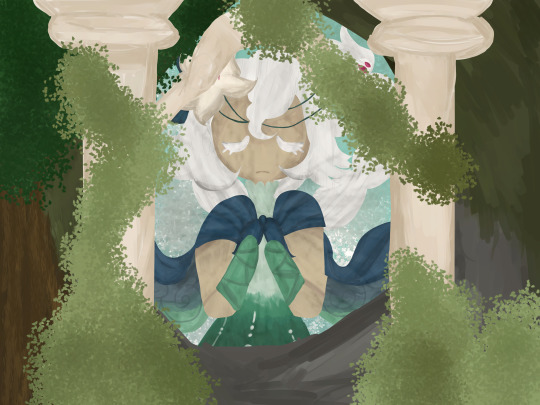
White Lily Cookie update - Main / Home screen [Not official]
Pfp version below [Credit if used]
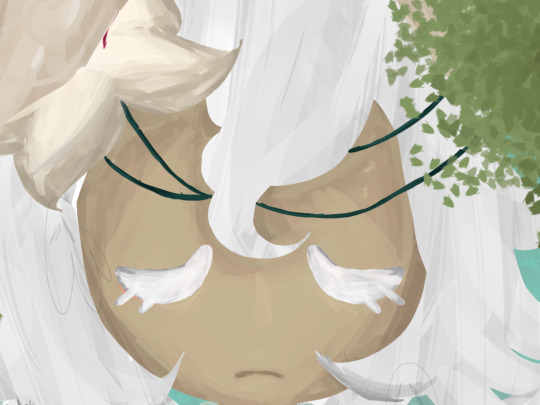
#white lily cookie#white lily crk#cookie run fanart#cookie run kingdom#cookie run#crk fanart#cr kingdom#digital art#Fanart#This took 17 hours lol.#It was really fun to make!I really hope they base her kingdom often ancient Rome. Cause that's what I did#Plus I think it would suit the kingdom nicely but \('v')/
21 notes
·
View notes
Text

Cartaginian noble woman during the 1st Punic war
#armored ladies#armored women#character design#illustration#historical costuming#suit of armor#ancient history#ancient rome#historic art#characterillustration#oc character#character art#character illustration#digitalillustration#digitaldrawing#digital art#sketch#procreate#my art#artwork#fantasy#fantasy character
9 notes
·
View notes
Text
I never tried to dress dark academia I tried to dress like my Latin teacher so you know... different route same outcome
0 notes
Text
I imprinted on my sixty year old professor like a baby chick
#father issues#shitpost#i miss his silly outfits#he wore converse and suits#unhealthy attachments#i need to start therapy again because i get too attached to older men and seek their approval#its gross of me#except its my lack of a stong paternal figure#chicken#baby chicken#chick#tagammemnon#ancient greek#ancient times#ancient rome#i miss my 60 year old baby girl
1 note
·
View note
Text

Cold I have run out of newer art pieces to post for the moment, but heres an old one. Hopefully its good enough for now! (I know its not very good sorry, character owned by my friend Manticore)
#digital art#art#artwork#whitewintertigerdoesart#original character#roleplay character#mech suit#amoeba#manticore#ancient rome
0 notes
Text
The toga in Ancient Rome wasn’t an everyday garment by any means. It was a giant piece of cloth you draped over yourself without any pins or knots. You basically had to tuck it into itself and partially hold it in place with your left hand. Your right hand was for gesturing. They were a formal garment for special occasions and notoriously cumbersome and uncomfortable.
Most people in Ancient Rome wore tunics or Greek style pinned garments with cloaks. Much more comfortable. You can actually tie and pin them in place so you’re not stuck trying to hold in place a big-ass heavy piece of wool cloth all day long.
The idea that Romans wore togas every day based on some carvings we have is like if future people thought we all wear business suits all the time because they’re only basing how 21st century people dress on official US presidential portraits or something.
4K notes
·
View notes
Text
ANCIENT ROMAN NECESSITIES. PART 1: WOMEN
I know, it's very unexpected. I've been having lots of fun with the Test of Time challenge, and then I got to Ancient Rome… and the fun ended :/ enormous respect to all creators who have made cc for that era, but it's just not enough. I hereby present to you the results of my latest hyperfixation.

the meshes are my own, frankenmeshed from maxis meshes and modified. no need to fret about violating my TOU, because I don't care. use, modify, recolor, include. they all should have fat and pregnancy (tf-af) morphs.
1) long-sleeved, low-waist tunic. because of… common sense reasons, it's suited best for women who are more well-off. tf-ef, 28 swatches. DOWNLOAD
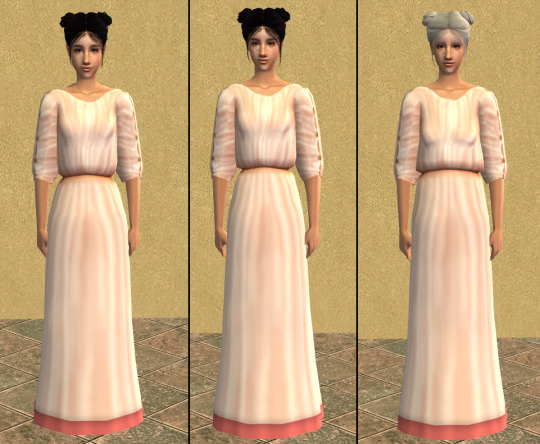
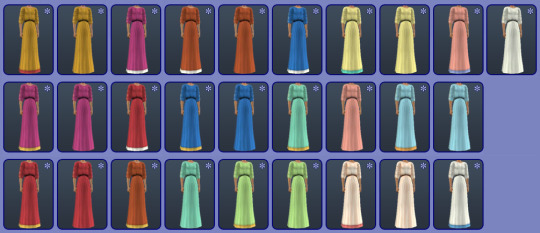
2) tunic with a stola; again. tf-ef, 73 swatches… I am sorry. I went ham. the actual Romans probably weren't THAT fun with their color combinations, anyway, but my sims Romans will be. they all have pretty borders, for the sake of consistency. DOWNLOAD


3) simple shorter tunic for working class women. tf-ef, 20 swatches, no fancy dyes or borders. DOWNLOAD

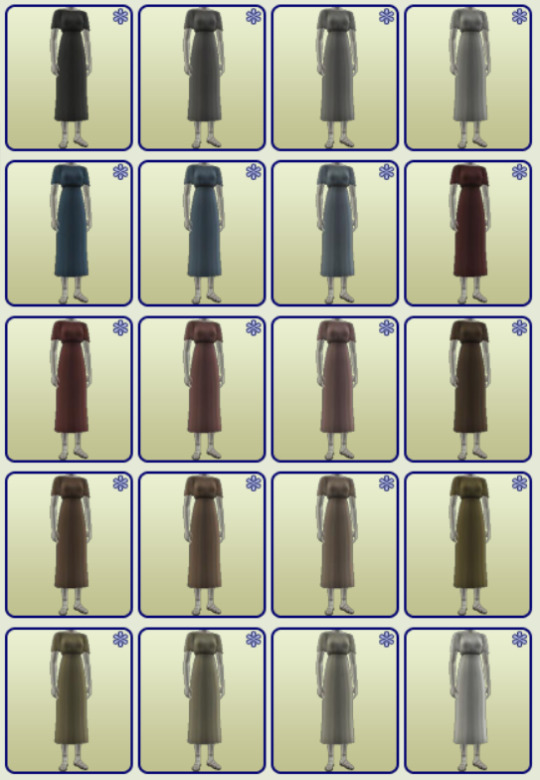
4) girls: shorter basic tunic and longer fancy one. those aren't as different, I guess. DOWNLOAD SHORT | DOWNLOAD LONG

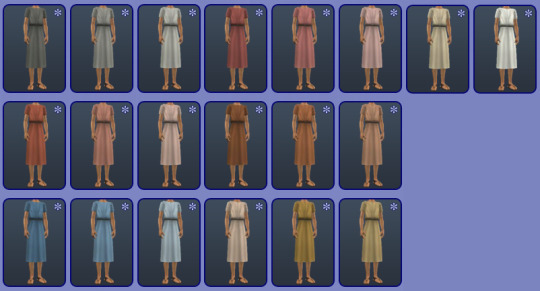

that was a lot. if you encounter any issues, don't hesitate to contact me! also, my post-creation aversion is kicking in, so I hope you'll enjoy this more than I do :D
150 notes
·
View notes
Note
I wanted to say there s something almost unsettling about the way you draw Lucullus (in a very good way) but I couldn't quite figure out what it was until you mentioned that you give him light eyes!! Attention to details as always *chefs kiss*
that was actually the first time I’ve posted him with the light eyes! if he comes across as unsettling or weird in a scene, this is both by design because it’s my end goal (lucullus has a different narrative style guide from everyone else) and a by product of wishing I could model the appearance of ancient rome lucullus after jung sung il as do yeong in the glory
#unfortunately I cannot have a man walking around in a sexy three piece suit. in Ancient Rome. UNFORTUNATELY#in some ways I’ve put Lucullus in a different narrative genre to compensate lmaoooo#When I get this out of my system I’m going to give him the Brothers treatment that A&L and V&V have#ask tag
20 notes
·
View notes
Text
A Human's Touch

Bill Cipher/Reader
Word Count: 3k

“A deal?”
The word felt sour in your mouth, coating your tongue in uneasiness and sliding down your throat to turn your stomach into a grumbling ball of nerves.
Bill nodded with a grin. “Deal, bargain, arrangement, whatever you want to call it! All that matters is that I’m offering you a first class ticket into my very own glorious abundance of knowledge.”
“In exchange for…” You continued, a question encompassing the end of your statement.
Breath lodged in your throat, you waited, the silence barely loud enough to conceal the soft thump of your beating heart.
“You.”
That sure as hell wasn't what you were expecting.
“Excuse me?”
“Just the mind and body. You can keep your soul, I don’t need that silly old thing," He chuckled. “Story short is, I've got a chore that needs handling and I need a physical flesh packet to do it. So, whaddaya say?”
With that tone, one would have thought he had just asked a neighbor for a stick of butter. The absolute ludicrousness of the situation had you scoff. “Absolutely not.”
Clicking his tongue in disappointment, Bill slowly reverted back into his original form, human stature shifting and condensing into that golden triangle. “We’ll see.”
You raised an eyebrow. “What’s that supposed to mea-”
“But I’ll offer you a compromise. And believe me when I say I don’t offer those to just anybody.” It occurred to you that you had just now realized how his form glowed whenever he talked, each syllable pulsing with spectral luminescence. “I’ll stick around and you can study me. And keep that pretty little meat-suit as a bonus.”
“Why would I… I’m a psychology major, not a cryptozoologist student. Or whatever you would be classified under,” you muttered.
“You’re trying to master the mind, doc. And I guarantee you, there’s no mind as interesting as this one! I’m an enigma, a mystery; and I know that’s something you brainiac types just can’t resist!” His eye began to showcase a myriad of different landmarks and time periods, ranging from the Black Plague to Ancient Rome’s gladiatorial fights. Whether or not he had actually seen or experienced any of them, you weren’t sure. “All I need you to do is find something for me.”
“And what would that be?”
With a snap, a short stack of papers fell into your arms. “Just a silly old landmark, really. That’s where I’m trying to go, but I’ll find my puppet in the meantime.”
Every sheet was marked with numerous pictures of what looked like ancient architecture, each matched with a corresponding set of coordinates. Save for the one at the bottom, the structure appearing to be a crude drawing next to a row of question marks.
A puzzle.
“Want a trial run?”
You glanced up at him in question.
“Give me ten seconds inside that head of yours to show you what you’re missing out on. I promise you won’t regret it.”
Curiosity tugged at your chest, the sting strong enough to overshadow the warning bells going off in your brain. “Ten seconds.”
“Cross my heart.” He held up a hand, fingers wrapping around one another to bind the promise between voice and flesh.
Every fiber of your being was begging you to back away from the cliff side, mental voices pleading for a retreat to where it was safe; predictable.
They clamored with one another, a chorus that had been overwhelmed with singers, each vying for your attention to create a symphony of disorder. Their call jerked at your sense of logic, slowly drawing your feet further and further away from the overhang.
Then you jumped.
“Okay.”
The word had barely left your lips before you began regretting it, but the complete and utter feeling of turbulence over washing your perception left no time for remorse. It was like your consciousness had been yanked back through eyes that you couldn't open, the mortal realm as you knew it shadowed in a blanket of pure ebony.
But then, in a single beat, everything changed.
You were falling.
No.
That definitely isn't it.
Warmth prickled at your limbs, now buoyant and hovering weightlessly, like your entire body had been submerged into a pool of water. Liquid air embraced you, floating under your clothes and gently tugging the fabric upward. Loose strands of your hair did the same, the levity tender and benign enough to leave no pain. The peacefulness swimming throughout your form was enough to distract you from the complete lack of somatic bodily sensations, whether it be the fading ache on your thumb from the hangnail that had been picked off yesterday or the beat of your heart.
The woven veil of darkness was lifted from over you, senses freed from its blinding threads and allowing you to look around.
A silken sky encased you from every angle, shades of purples and blues colliding with the black. They welcomed one another happily, hues binding together to form a tapestry of radiance. Clusters of stars, each blooming with its own spectral iridescence, were splattered across the galaxy.
You reached out, tiny celestial bodies caressing your outstretched fingers and tickling at the skin. One drifted closer, quiet glow reflecting on the palm of your hand.
Up close, you noticed that it wasn't just light, but an image was molded in its bright center.
A cabin in the woods, both covered in snow like powdered sugar, flickered within the orb. Firelight could be seen from inside, warm reds and oranges colliding with the stark white flakes still falling around the scene.
The lodge, although you couldn't see, would have been scented like hot chocolate and had a brightly lit Christmas tree in the middle of the living room.
Small waves of memories washed over you as the minuscule sun slowly started to hover away. You could have sworn that you heard laughter, a little girl's, as it escaped from your hold, joining its clustered constellation of a family.
You reached out once more, fingertips gracing another star as you were submerged in the sound singing and the smelled of birthday cake.
Then you blinked.
And it was gone.
"So, whaddya think? Pretty neat, huh?" You jumped at Bill's voice, eyes readjusting to the harsh lighting of your dorm room. The muted thump had returned to your chest, organ beating rapidly from the sudden change.
"What was that?"
"I like to call it the Mindscape." He pressed a small, black finger against your temple. “A metaphysical representation of your mind.
Your bed frame rocked as you flopped down in shock. "And you can just do that whenever you want? With whoever you want?"
"And so much more than that."
"It's..." You raised an arm above your head, imagining those twinkling lights swirling through your fingers once more. "It's incredible."
"So, does that sway you or what?"
You sat up, quiet unease weighing in your chest. "Why me? We both know that there's a lot of people out there who would've taken that deal. So, why stick around?"
Bill raised both of his arms, the closest he might ever get to a shrug in the form lacking shoulders. "Why not? You were the one who shook my hand, so you’re basically stuck with me until I find someone else interesting enough to use. Besides, I enjoy imparting some wisdom to you mortals every few millennia or so."
The response wasn't genuine, at least, not completely, of that you were almost positive. There was the idea of something more that was underlying the pleasant message and honeyed promises, something that you would become trapped in, unable to dig your way out once you actually knew you were being buried alive.
But you had already jumped.
What's the harm in just letting yourself fall a little longer?
"Hand me the papers."
⭒⋆△⋆⭒
It had been two days since you had found Bill.
Two days since you had agreed to aid in his search.
And exactly forty-six hours since you had realized how utterly annoying he could become.
He was like a power hungry toddler, whizzing around your room and rifling through every drawer, shelf, and cubby in interest. He followed you around almost everywhere, whether it be to the nearby vending machine or your school’s computer lounge.
And that definitely wasn't the worst of it.
"Can you... can you maybe leave? Or at least, like, turn around." you had asked yesterday, a set of pajamas hanging over your arm as you attempted to change.
"You really think I can't see under there?" He cackled as a harsh warmth spread over your cheeks. "If you really wanted, I can look all the way down to your nervous system. Pretty cool trick if I do say so myself.”
"Perv."
“Ha! You wish, toots.”
There were random blocks of time, those you cherished near and dear to your heart, where he would randomly just disappear, popping out of existence to somewhere you honestly did not care to know about.
Such as the afternoon the day before, when you had been left to mercifully sleep passed the ‘pm’ to your heart's desire.
This morning, however, you had been plucked from the beautiful darkness with that vexingly flat tone.
“You’re a pretty mumbly sleeper. Get nightmares or something?”
Jumping up with a yelp, your body had slipped from those bewitching silk sheets, plummeting to the floor with a groan.
You had never been more thankful for opting to stay in your dorm over break, the interaction with any other sentient being besides the therapy cat kept in the campus library probably would have sent you straight over the edge.
Still, his presence was the slightest bit comforting, if you harnessed every bit of patience in your being. Especially since you had the more-than-slight inkling that it wasn't exactly his personality, but the enjoyment of tormenting you that brought upon the constant irritant.
If you just ignored him, he would calm down.
And surprisingly, he did.
But not by much.
"I'm just saying, if you're having bad dreams, I could fix that up real quick." Bill flew over to your desk side, papers strewn across the wood grain. "Are you even listen-"
"Done."
"You're finished." The response was less an assured statement than it was a question waiting to be affirmed.
"Yep. The other nine structures make an almost perfect pentagram, so the tenth should be right..." you tapped a finger against the map, brightly highlighted 'x' filling in the gap. "here."
One giant eye blinked back at you, watching as you tossed the notes aside and pushed your chair back.
"Where are you going?"
"To bed." If it wasn't two in the morning, you might have worded the retort more politely, but among the tiny grains of energy left in you, there was hardly enough to care. Still, you offered a small smile of remorse as you slid under the covers, blue light illuminating your dorm room.
Fingers gliding across your keyboard, your eyes flit from cover to cover, accessing your options before confirming your choice with a click. Bill watched you work, silently hovering to your side as you grabbed a pillow to prop your laptop up with. The soft periwinkle coating your features abruptly turned to black before slowly fading to a deep red, title screen showcasing the Paris catacombs loading in.
You picked up your recently formed companion from the corner of your vision. "It's a horror movie. You actually might like it, being, ya know... Which sounds a lot more offensive when I say it out loud."
He didn’t seem to mind or even notice as he floated next to you, oversized sclera and snakelike pupil reflecting the events playing out on the monitor. As the minutes ticked by, he levitated inches closer, finding residence on your left shoulder. At first, you thought of swatting him away, but ultimately paid no attention as the creature settled in next to your collarbone, stamina properly depleted from a day of nonstop work.
It was fascinating to watch, or to listen might be a more accurate term, how Bill reacted to the film, chaotic cackle ringing out anytime a character was injured or met their untimely end. You noted how he particularly enjoyed when suffering, specifically that of which was emotionally traumatic, was involved, such as when one of the individuals got sucked into a burning car and ended up buried alive within the span of two minutes.
It was spine tingling, sure, but interesting to view nonetheless, especially coming from someone who had been oddly engaged in serial killer cases from age fourteen. You found yourself silently analyzing every snarky comment, chuckle, or declaration about how he could have done better rather than actually paying attention.
According to him, falling down a well and breaking your neck was ‘boring’ and getting beaten with a rock to death was ‘uninspired.’ Both statements were extremely concerning, but clearly not alarming enough to keep your eyes open for long. Mental fatigue plagued your mind, infesting your questions with a soothing fog until sleep finally claimed you.
Your spector was gone by morning.
Sunlight streamed through your blinds, bright gleam marking your room with its fractured motif. You slipped from the comforting warmth of your sheets with a yawn, rolling your neck around and ushering away those tiny pops from hours of unuse. Despite the moderate sluggishness weighing down your limbs, you were quite surprised at how good you felt.
Nightmares had always been fairly regular for you, whether it be something as mildly mundane as being late to class or as distressing as being chased by an axe wielding maniac.
Like it or not, Bill had been right; you were a stressful sleeper.
Over the years, you had slowly habituated to the dreams, not allowing those ghosts of visions to haunt you too much through waking hours. Regardless, it was hard to shake the ickiness brought upon by those particularly stirring visions, especially when the rest of the world was dead, that dreadfully lonely feeling only empowered by the darkness and silence surrounding you. Every once in a while, you would jolt awake, sweat coating the edge of your brow as you willed your heart to slow, forcing uplifting scenarios into the forefront of your train of thought.
Even when it wasn't a nightmare, there was almost always something. Maybe a sporadically flash of colored light or recollection of something weeks ago. In fact, a dreamless evening almost always meant a lack of sleep.
However, this seemed to be the complete opposite.
But you definitely weren’t complaining.
Rifling through the minifridge beside your bed, you flipped through various breakfast options, determined to start a morning off on the right foot for once. You had just settled on a plastic box of leftovers as a sharp snap sounded right next to your ear, causing you to jump and smack your head on the microwave above.
A string of curses shot out as you waited for the throbbing to subside. You caught a glance at your triangular shaped companion, who seemed less than apologetic at the frightening entrance as he made himself at home on your bed. The suspicions were deemed correct as he shifted into a human seconds later, if the haughty grin gracing his features was any indication.
“I thought you left,” you sighed.
“Can’t get rid of me that easy,” he replied, watching while you worked to heat up your food. “I was just checking in with some friends nearby.”
‘You’re basically stuck with me until I find someone else interesting enough to use’
Well, dammit.
“I guess we can get started then.” Moving to take a seat by your desk, you noticed the slight twinge of surprise tugging at his brow. “You said you’d let me study you. I don’t have anything to do for the next two weeks anyhow.”
“Ask away. I’m an open book.”
I doubt that
“So, what were you doing again?”
Your new patient rolled his eyes, clearly annoyed at having to repeat himself. “Visiting old friends, just to let them know of my fabulous return to society.”
Very vague; great
“Were they human?”
“Ha! As if I would ever consider one of you pea-brained meat sacks a friend! Besides, you guys die way too quickly to make a difference anyway. Do you know how many puppets I’ve had to replace because they keep kicking the bucket?”
“Oh… I’m sorry about that.”
Incredulousness soaking his tone, he scoffed. “I don’t need your sympathy. Those geezers were basically getting ready for the grave by the time they were in a cradle.”
Honestly, the statement made sense. If you really thought about it, people had begun the slow process of expiration the moment they had their first breath. Still, the way Bill phrased it gave you the idea that he thought about his own mortality, or immortality, as completely different from someone of your own species.
“So, uh, how old are you then?”
“Older than you could count, doc,” he replied, getting comfortable with his arms propped behind his head.
“And how does that make you feel?” You pried. “Knowing that most of the allies you make will die before you even really notice they’re there.”
He cracked open what you believed to be his good eye, though you weren’t exactly sure whether or not he could see out of the black one. “Perfect, obviously. I couldn’t care for you guys if I even tried. Let’s move on to the less stupid questions.”
You frowned. “Fine. Is your name actually Bill? I mean, no offense, but it seems just a tad bit anticlimactic for a supernatural entity like you.”
“Nope. But you wouldn’t be able to pronounce the real one.”
“Where were you born? Did you have a family or-”
“Oh, come on. I thought this was going to be interesting.” He jumped up, moving over to where you were sitting and motioning to the laptop still on your bed. “Let’s get down and dirty, into the fun stuff.”
A patience-capturing breath raddled through your lungs. You slipped around him to grab the computer, trying to ignore the way your pulse sped up in nervousness at the close proximity. “Alright. What would you like to talk about then?”
Excitement flashed in his eyes. “Let me show you.”
#bill cipher#bill cipher x you#the book of bill#gravity falls bill#gravity falls x reader#gravity falls imagine#gravity falls#enemies to lovers#gravity falls fanfiction#bill cipher x reader
68 notes
·
View notes
Text
I know the last time I gave y'all a snippet from my Valgrace Hallmark fic it was sad, so have some absolutely disgusting flirting this time instead. >;3c
Leo made a comically disgusted sound. “Really? You’d put all my hard work to waste like that? I know I don’t like Audies, but she is a beautiful car. Surely you care about her a little.”
Jason involuntarily wrinkled his nose. “Uh, not exactly. Very few fond feelings about this thing, actually.”
Leo paused his work and looked up at Jason with one eyebrow cocked up. “Something tells me there’s a bit more to that story.”
Jason considered that and shrugged. “Not really. I mean, it was a gift from my dad for graduating law school. I mean, it’s a really nice car, and it’s useful when I need it, but I specifically asked him to not buy me a sports car because I don’t like driving.”
“Yeah? What did you want instead?”
“Promise you won’t make fun of me for being a rich kid?”
“You wouldn’t like me half as much as you do if I could make promises like that,” Leo countered, grinning like a shark. Jason just chuckled and dropped his gaze, seeing as he couldn’t even begin to argue. Leo poked him with the wrench in his hand. “Come on, nepo. Tell me what you asked Lawyer Santa for Christmas.”
Jason let out a heavily put-upon sigh. “Rome.”
“Rome? You asked your dad for a city and you wanted me to refrain from making fun of you?”
“No, not the whole city,” Jason corrected, rolling his eyes. “I just meant a trip. I’ve been obsessed with Ancient Rome since middle school, and I wanted to see it in person.”
“Yeah?”
“Mm-hmm. I actually went and got a tattoo when I found out my dad canceled my trip. Probably not my best decision, but I like it.”
Leo’s eyes were bright with interest. “Can I see?” Then he paused and looked at Jason suspiciously. “Wait, it’s not on your ass, is it?”
“One way to find out,” Jason quipped, reaching for his belt. When Leo turned vermillion and spluttered, he laughed. “No, it’s not on my ass. It’s on my forearm. Look.”
Jason rolled up his shirt sleeve and Leo shuffled around the car to do as he was told. Rough fingers delicately traced over the laurel design and each letter, leaving behind a grease smear and sending a shiver up Jason’s spine. “SPQR? What does that mean?”
“Senatus Populusque Romanus,” Jason recited. “It’s Latin for the Senate and People of Rome.”
“You know,” Leo said conversationally, still running his fingers over the crisp clear lines of Jason’s tattoo. “You told me I couldn’t make fun of you for being rich, but there’s one thing you forgot.”
“Yeah?” Jason asked, pretending he wasn’t starting to feel a little breathless. “And what’s that?”
Leo craned his neck to look up at him, his eyes sparkling and all of his teeth glinting like a smug crocodile. “You didn’t tell me I couldn’t make fun of you for being a fucking dork.”
Now it was Jason’s turn to splutter while he was laughed at. After a moment, Leo hip checked him and teased, “Don’t worry about it. Dork suits you. Very well, I might add.”
64 notes
·
View notes
Text
Beetlejuice's Backstory and the Black Plague 💚🕷️🥀💀 PART 3

Good evening! As promised, here’s Part 3 of my series on Beetlejuice’s past and movieverse. Today, we dive deeper into historical fashion, analyzing the outfits of Beetlejuice and Delores to uncover their personal stories.
If you missed the earlier parts, check out PART 1 and PART 2.
Warning: This post contains SPOILERS for ‘Beetlejuice Beetlejuice’ (2024)... and many, MANY speculations.
Quick recap: In Part 1, we discussed the Plague. In Part 2, we delved into Beetlejuice’s past, questioning the claim that he died over 600 years ago.
I wondered: is that really true? Why does his clothing reflect the Baroque style, then?
That's right! In Part 3, I confirm my previous point: there are several clues suggesting that Beetlejuice most likely lived during the Baroque era - a cultural movement that began in Rome at the end of the 16th century and faded around 1750. Here is the list of the clues I noticed:
The lace neckband around BJ's neck.
His three-piece wedding suit.
Delores off-the-shoulder neckline and puffed sleeves.
The bird masks used by Delores and the undertakers.
AliveBeetlejuice first outfit (when he's stealing from corpses): specifically, the pirate shirt and the type of shoes.
Keep in mind that most of these elements were revolutionary novelties of the 16th-17th century. Here is proof for every. single. one of them.
The Lace Cravat

A behind the scenes still of Michael Keaton in 'Beetlejuice Beetlejuice' vs. the portrait of Jacob de Witte, Lord of Haamstede (Netherlands). The artwork was made by Jan Mijtens in 1660.
The first cravat, the predecessor of modern neckties and bow ties, originated in France during Louis XIV’s reign as a political and fashion statement. (Although the early idea comes from the Ancient Roman focale, used around 200 CE). The King was inspired by a particularly eye-catching necktie wore by Croatian mercenaries as part of their uniform. The new article of clothing quickly became a fashion staple for high-ranking men across Europe.
In its use, it represented the evolution of the common handkerchief, already popular in the 1500s as a practical tool, a flirty decoration, and a status symbol. I believe the variant Beetlejuice is wearing in the picture is called ‘jabot,’ and is one of the older, simpler versions.
Lace, often used in cravats, highlighted the wearer’s wealth. Italian lace, especially from Venice, was highly sought after by the European elite since the 15th century, when ruffs and collars were in vogue.
This detail suggests two possibilities:
Beetlejuice might have been an impoverished aristocrat (or a rich merchant) clinging to his title until the end. This could also explain the ring on his index finger, symbolizing power or family ties. Or both.

Alternatively, he may have been someone who strongly wished to be part of the elite.
Jacket and Breeches

Aristocratic fashion, 1630 (Victoria & Albert collection) vs. What Beetlejuice wore in the wedding scene.
Another standout innovation of the Baroque period was the introduction of the three-piece men’s suit, known as the ‘Habit à la française.’
This ensemble included a tailcoat (a calf-length jacket), a coat (a long waistcoat), and knee-length breeches. Like the cravat, this fashion was adopted across Europe. As you can see, Beetlejuice is perfectly embodying this fashion, which evolved and remained popular until the 19th century. Interestingly, one shoe is missing.
Pirate Shirt
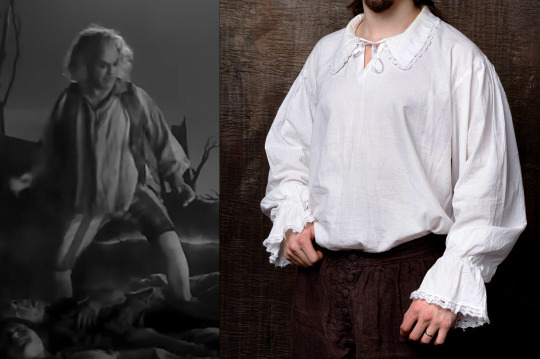
Originating in the 16th-17th century, the ‘poet shirt’ or ‘poet blouse’ remained popular through the Romantic era. These multi-purpose shirts served as both underwear and nightwear, featuring long tails that reached mid-thigh or knee. The body and sleeves were gathered at the collar and cuffs, creating a full, loose fit.
Delores' Outfit

For comparison, I’ve included an illustration of noblewomen’s fashion at the court of Louis XIII (died 1643). His successor, Louis XIV, made France a cultural and fashion beacon for the next two centuries.
In the movie, Delores wears two nearly identical outfits: long dresses with puffed sleeves ending just below the elbow, a corset, and an off-the-shoulder neckline. This style aligns with 17th-century trends when fashion became more comfortable and relaxed.
The black color suits her character’s personality and role in the film, possibly hinting at a connection to the late Renaissance and the Spanish Court.


In fact, during the reign of Charles V (1500-1558) and his son Philip II (1527-1598), Spanish aristocracy particularly favored the black color, as it represented austerity and power for both men and women. Additionally, a deep shade of black was particularly difficult to achieve with the dyeing methods of the time, making those fabrics quite expensive to make.
However, The Spanish style was quite the opposite to what France later proposed: it consisted in a severe and somber luxury, which increased in opulence as the time passed. As Spain happened to be the beacon of fashion before Louis XIV came along, it's only natural that black rapidly became quite popular all around Europe as well. The color was particularly appreciated by the members of the middle class in Protestant nations and, apparently, in Italy as well.
Finally, keep in mind that 'Delores' is a variant of the more common 'Dolores'. Both names have Spanish origins and means 'sorrows'.
So what do we think? Was Beetlejuice from a rich family? Was Delores a Spanish witch?
Who knows! But I’m willing to dream and speculate!
Until the big reveal from Tim Burton himself in the now teased but not confirmed yet sequel, have a fantastic week!✨
#beetlejuice movie#tim burton#michael keaton#film theory#film analysis#film stills#cinema#film#movie#beetlejuice#betelgeuse#beetlejuice sequel#beetlejuice beetlejuice#europe#italy#beetlebabes#italian#dark#plaguecore#baroque#17th century#history#renaissance#historical fashion#delores#beetlejuice 2024#black plague#beetlejuice 2#beetlejuice & lydia
74 notes
·
View notes
Text
hogwarts, 1975: when the kids start smoking weed.

KERRY COLT . . . LIFE OF THE PARTY, and who funnily enough decided to get out of her mum during her baby shower. her nickname: cherry. cherries, often associated with something sweet but with a bit of an edge: this matches her sassy, and adventurous nature. with a love for bright, bold fashion — typical of the 70s; kerry also wears a signature scent that contains cherry. cherries are also often associated with energy, youthfulness, and confidence, all qualities that fit her playful, and witty personality.
GRYFFINDOR . . . the house of the bravest and, in the words of regulus black (her nemesis) — house of idiots who don’t think before acting and then regretting everything the morning after during breakfast. (he’s right).
KERRY …. honestly, how can someone so witty as her be the HEIR OF THE COLT DINASTY ? house of colt is known for their expertise in alchemy: a revered magical discipline in italy, tied to the country's rich history of scholars like leonardo da vinci. the colt family also had deep ties to italy's magical history, acting as the keepers of ancient magical secrets linked to rome's mystica past. they safeguarded ancient spells, and relics from the time of the roman empire, making them both feared and respected for the ancient power they wield.




her beautiful wand.
wood: cherry. known for its vibrant energy and connection to strong-willed, charismatic individuals. cherry wood also symbolizes a love for adventure, self-expression, and a fiery passion, making it perfect for kerry's gryffindor bravery, and bold, sassy personality.
core: phoenix feather. a core that represents resilience, bravery, and emotional depth. phoenix feathers are attuned to their owner's emotions and magical abilities, making it ideal for someone who is fiercely loyal to friends, emotionally intense, and always ready to rise above challenges.
lenght: 10¾ inches. slightly on the longer side, reflecting my boldness and the ability to stand out. the length suggests a wand suited for someone with a strong personality, confident in their own skin and ready to take on whatever comes their way.
flexibility: reasonably supple. this flexibility indicates a wand that is versatile and adaptable, much like her adventurous and witty nature. it suggests someone who is quick to change course when needed and has a natural flair for handling unexpected situations, but still maintains a solid sense of self and conviction.

𝒇riendgroup. james potter. sirius black. remus lupin. lily evans. marlene mckinnon. mary mcdonald.
𝒃oyfriend. regulus black.




#kerry’s marauders reality#reality shifting#shiftblr#shifting antis dni#shifting blog#shifting community#shifting consciousness#shifting motivation#shifting#shifting diary#shifting to hogwarts#shifting to desired reality#shifting realities#desired reality#shiftingrealities#shifters#shifting script#shifting to harry potter#shifting to marauders era#shifting to my dr
68 notes
·
View notes
Text
Word List: Fashion History
to try to include in your poem/story (pt. 3/3)
Pelete Bite - a fabric created by the Kalabari Ijo peoples of the Niger Delta region by cutting threads out of imported cloth to create motifs
Pelisse - a woman’s long coat with long sleeves and a front opening, used throughout the 19th century; can also refer to men’s military jackets and women’s sleeved mantles
Peplos - a draped, outer garment made of a single piece of cloth that was worn by women in ancient Greece; loose-fitting and held up with pins at the shoulder, its top edge was folded over to create a flap and it was often worn belted
Pillow/Bobbin Lace - textile lace made by braiding and twisting thread on a pillow
Pinafore - a decorative, apron-like garment pinned to the front of dresses for both function and style
Poke Bonnet - a nineteenth-century women’s hat that featured a large brim which extended beyond the wearer’s face
Polonaise - a style of dress popular in the 1770s-80s, with a bodice cut all in one and often with the skirts looped up; it also came back into fashion during the 1870s
Pomander - a small metal ball filled with perfumed items worn in the 16th & 17th centuries to create a pleasant aroma
Poulaine - a shoe or boot with an extremely elongated, pointed toe, worn in the 14th and 15th centuries
Raffia Cloth - a type of textile woven from palm leaves and used for garments, bags and mats
Rebato - a large standing lace collar supported by wire, worn by both men and women in the late 16th and early 17th century
Robe à L’anglaise - the 18th-century robe à l’anglaise consisted of a fitted bodice cut in one piece with an overskirt that was often parted in front to reveal the petticoat
Robe à la Française - an elite 18th-century gown consisting of a decorative stomacher, petticoat, and two wide box pleats falling from shoulders to the floor
Robe en Chemise - a dress fashionable in the 1780s, constructed out of muslin with a straight cut gathered with a sash or drawstring
Robe Volante - a dress originating in 18th-century France which was pleated at the shoulder and hung loose down, worn over hoops
Roses / Rosettes - a decorative rose element usually found on shoes in the 17th century as fashion statement
Ruff - decorative removable pleated collar popular during the mid to late 16th and 17th century
Schenti - an ancient Egyptian wrap skirt worn by men
Shirtwaist - also known as waist; a woman’s blouse that resembles a man’s shirt
Skeleton Suit - late 18th & early 19th-century play wear for boys that consists of two pieces–a fitted jacket and trousers–that button together
Slashing - a decorative technique of cutting slits in the outer layer of a garment or accessory in order to expose the fabric underneath
Spanish Cape - an outer wrap often cut in a three-quarter circle originating from Spain
Spanish Farthingale - a skirt made with a series of hoops that widened toward the feet to create a triangular or conical silhouette, created in the late 15th century
Spencer Jacket - a short waist- or bust-length jacket worn in the late 18th and early 19th centuries
Stomacher - a decorated triangular-shaped panel that fills in the front opening of a women’s gown or bodice during the late 15th century to the late 18th century
Tablion - a rectangular panel, often ornamented with embroidery or jewels, attached to the front of a cloak; worn as a sign of status by Byzantine emperors and other important officials
Toga - the large draped garment of white, undyed cloth worn by Roman men as a sign of citizenship
Toga Picta - a type of toga worn by an elite few in Ancient Rome and the Byzantine Empire that was richly embroidered, patterned and dyed solid purple
Tricorne Hat - a 3-cornered hat with a standing brim, which was popular in 18th century
Tupu - a long pin used to secure a garment worn across the shoulders. It was typically worn by Andean women in South America
Vest/Waistcoat - a close-fitting inner garment, usually worn between jacket and shirt
Wampum - are shell beads strung together by American Indians to create images and patterns on accessories such as headbands and belts that can also be used as currency for trading
Wellington Boot - a popular and practical knee- or calf-length boot worn in the 19th century
If any of these words make their way into your next poem/story, please tag me, or leave a link in the replies. I would love to read them!
More: Fashion History ⚜ Word Lists
#word list#fashion history#writeblr#dark academia#terminology#spilled ink#writing prompt#writers on tumblr#poets on tumblr#poetry#literature#light academia#fashion#lit#studyblr#langblr#words#linguistics#history#culture#creative writing#worldbuilding#writing reference#writing resources
130 notes
·
View notes